Apple iMac G5 User Manual

iMac G5
User’s Guide
Includes setup, expansion, and troubleshooting information for your iMac G5 computer
K Apple Computer, Inc.
© 2004 Apple Computer, Inc. All rights reserved.
Under the copyright laws, this manual may not be copied, in whole or in part, without the written consent of Apple.
The Apple logo is a trademark of Apple Computer, Inc., registered in the U.S. and other countries. Use of the “keyboard” Apple logo (Option-Shift-K) for commercial purposes without the prior written consent of Apple may constitute trademark infringement and unfair competition in violation of federal and state laws.
Every effort has been made to ensure that the information in this manual is accurate. Apple is not responsible for printing or clerical errors.
Apple
1 Infinite Loop
Cupertino, CA 95014-2084 408-996-1010 www.apple.com
Apple, the Apple logo, AirPort, Apple Store, AppleTalk, Final Cut Pro, FireWire, iLife, iMac, iMovie, iPod, iTunes, Mac, the Mac logo, Mac OS, Macintosh, and QuickTime are trademarks of Apple Computer, Inc., registered in the U.S. and other countries.
Finder, iCal, iDVD, iPhoto, iPod, iSight, Rendezvous, Safari, and SuperDrive are trademarks of Apple Computer, Inc.
AppleCare is a service mark of Apple Computer, Inc., registered in the U.S. and other countries.
.Mac is a service mark of Apple Computer, Inc.
The Bluetooth word mark and logos are owned by the Bluetooth SIG, Inc. and any use of such marks by Apple Computer, Inc. is under license.
ENERGY STAR® is a U.S. registered trademark.
Other company and product names mentioned herein are trademarks of their respective companies. Mention of third-party products is for informational purposes only and constitutes neither an endorsement nor a recommendation. Apple assumes no responsibility with regard to the performance or use of these products.
Manufactured under license from Dolby Laboratories. “Dolby,”“Pro Logic,” and the double-D symbol are trademarks of Dolby Laboratories. Confidential Unpublished Works, © 1992–1997 Dolby Laboratories, Inc. All rights reserved.
The product described in this manual incorporates copyright protection technology that is protected by method claims of certain U.S. patents and other intellectual property rights owned by Macrovision Corporation and other rights owners. Use of this copyright protection technology must be authorized by Macrovision Corporation and is intended for home and other limited viewing uses only unless otherwise authorized by Macrovision Corporation. Reverse engineering or disassembly is prohibited.
Apparatus Claims of U.S. Patent Nos. 4,631,603, 4,577,216, 4,819,098 and 4,907,093 licensed for limited viewing uses only.
Simultaneously published in the United States and Canada.

1 Contents
Chapter 1 |
5 |
Getting Started |
|
|
8 |
What’s Next? |
|
|
9 |
What to Do When You Have Finished Using Your iMac G5 |
|
Chapter 2 |
11 |
Getting to Know Your iMac G5 |
|
|
12 |
iMac G5 |
– Front View |
|
14 |
iMac G5 |
– Back View |
16Learning About Mac OS X
17Customizing Your Desktop and Setting Your Preferences
18Connecting to a Printer
19Playing a CD and Connecting Headphones
19Keeping Your Software Up to Date
20Connecting a Camera or Other FireWire Device
20Connecting to a Network
20Using the Internet
20Transferring Files to Another Computer
21When an Application Freezes
22Getting Answers to Your Questions Using Mac OS Help
22Using Applications
Chapter 3 |
23 |
Using Your Computer |
|
24 |
Universal Serial Bus (USB) |
|
26 |
FireWire |
|
28 |
AirPort Extreme Wireless Internet and Networking |
|
29 |
Bluetooth Wireless Technology |
|
31 |
Ethernet (10/100Base-T) |
|
32 |
Audio Support |
|
34 |
External Video Support (VGA, Composite, and S-Video) |
|
36 |
Using Your Optical Drive |
|
38 |
Keyboard Controls |
|
39 |
Securing Your Computer |
Chapter 4 |
41 |
Enhancing Your Computer |
|
41 |
Installing Additional Memory |
3
|
47 |
Installing an AirPort Extreme Card |
|
51 |
Replacing the Internal Backup Battery |
Chapter 5 |
57 |
Troubleshooting |
|
57 |
Problems That Prevent You From Using Your Computer |
|
59 |
Reinstalling the Software That Came With Your Computer |
|
60 |
Other Problems |
|
61 |
Locating Your Product Serial Number |
|
62 |
Using Apple Hardware Test |
Appendix A |
63 |
Specifications |
Appendix B |
65 |
Care, Use, and Safety Information |
|
65 |
Cleaning Your iMac G5 |
|
65 |
Carrying Your iMac G5 |
|
66 |
Safety Instructions for Setting Up and Using Your Computer |
|
67 |
Connectors and Ports |
|
67 |
Avoid Hearing Damage |
|
67 |
Ergonomics |
|
68 |
Apple and the Environment |
Appendix C |
69 |
Connecting to the Internet |
|
71 |
Setup Assistant Worksheet |
|
73 |
Setting Up Your Internet Connection Manually |
|
74 |
Dial-Up Connection |
|
76 |
DSL, Cable Modem, or LAN Internet Connections |
|
82 |
AirPort Extreme Wireless Connection |
|
85 |
Troubleshooting Your Connection |
|
87 |
Communications Regulation Information |
Index |
93 |
|
4 |
Contents |
|
|

1 |
Getting Started |
1 |
|
||
|
|
|
Your iMac G5 has been designed so that you can set it up quickly and start using it right away. If you have never used an iMac G5 or are new to Macintosh computers, read this section for instructions on getting started.
If you are an experienced user, you may already know enough to get started. Be sure to look over the information in Chapter 2,“Getting to Know Your iMac G5,” to find out about the new features of this iMac G5.
Keyboard |
Mouse |
AC cord |
Telephone cord |
5

Follow the steps on the next two pages to set up your iMac G5.
Step 1: Plug in the power cord.
Step 2: To access the Internet, connect an Ethernet cable or phone cord.
|
|
|
|
|
|
|
|
|
|
|
|
|
|
|
|
|
|
|
|
|
|
|
|
|
|
|
|
|
|
|
|
|
|
|
|
|
|
|
|
|
|
|
|
|
|
|
|
|
|
|
|
|
|
|
|
6 |
|
Chapter 1 Getting Started |
|
|
|
||
|
|
|
|
||||
|
|
|
|
|
|
|
|
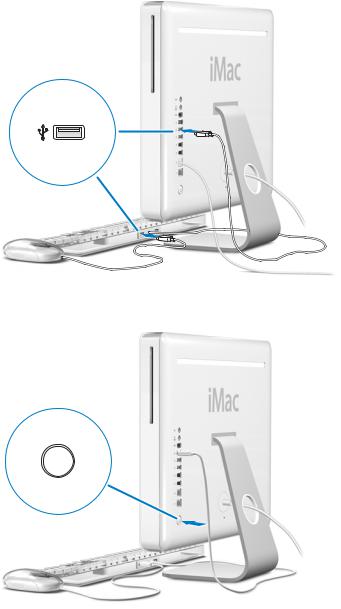
Step 3: Connect the keyboard and mouse cables.
Step 4: Press the power button (®) to turn on your computer.
®
Chapter 1 Getting Started |
7 |
|
|
Using a Wireless Keyboard and Mouse
If you purchased an Apple Wireless Keyboard and Apple Wireless Mouse with your iMac G5, see the instructions that came with the keyboard and mouse to set them up with your computer.
What’s Next?
You’ve done everything you need to get your iMac G5 up and running. The first time you turn on your computer, the Setup Assistant starts. The Setup Assistant helps you enter your Internet and email information and set up a user on your computer. If you already have a Mac, the Setup Assistant can help you automatically transfer files, applications, and other information from your previous Mac to your new iMac G5.
Transferring Information to Your iMac G5
You can use the Setup Assistant to automatically transfer information from another
Mac to your new iMac G5. To transfer information, make sure of the following:
•Your other Mac must have built-in FireWire and support FireWire Target Disk Mode.
•Your other Mac must have Mac OS X v 10.1 or later installed.
•You must have a standard 6-pin to 6-pin FireWire cable.
The Setup Assistant takes you through the process of transferring your information— just follow the onscreen instructions. Transferring information to your iMac G5 does not affect the information on your other Mac. Using the Setup Assistant, you can transfer:
•User accounts, including preferences and email
•Network settings, so your new computer is automatically set up to work with the same network settings as your other Mac
•Applications folder so that the applications you used on your other Mac are now on your new iMac G5 (you may have to reinstall some of the applications you transfer)
•Files and folders on the hard disk and partitions. This gives you easy access to the files and folders you used on your old Mac.
If you don’t use the Setup Assistant to transfer information when you first start up your iMac G5, you can do it later. Go to the Applications folder, open Utilities, and doubleclick the Setup Assistant icon.
Setting Up Your iMac G5 for the Internet
If you didn’t transfer your network settings, the Setup Assistant can also take you through the process of setting up your computer to connect to the Internet. For home users, Internet access requires an account with an Internet service provider (ISP). Fees may apply.
•If you don’t already have an Internet account, the assistant can set you up with one.
•If you already have an Internet account, see Appendix C,“Connecting to the Internet,” on page 69 for information you’ll need to enter.
8 |
Chapter 1 Getting Started |
|
|

Additional Information
If you would like additional information, see the following:
To learn about... |
See... |
Shutting down your computer or putting |
“What to Do When You Have Finished Using Your |
it to sleep |
iMac G5” below. |
|
|
An overview of the different parts of your iMac G5 |
Chapter 2,“Getting to Know Your iMac G5.” |
and some common tasks |
|
|
|
The additional information available in the |
“Getting Answers to Your Questions Using Mac OS |
onscreen help |
Help” on page 22. |
|
|
Using a specific feature of your iMac G5, or |
Chapter 3,“Using Your Computer.” |
connecting a digital device, such as an iPod |
|
|
|
Installing memory or an AirPort Extreme Card |
Chapter 4,“Enhancing Your Computer.” |
|
|
What to do if you have a problem with your |
Chapter 5,“Troubleshooting.” |
iMac G5 |
|
|
|
What to Do When You Have Finished Using Your iMac G5
When you have finished working with your iMac G5, you have two options.
Put Your iMac G5 to Sleep to Save Energy
If you will be away from your iMac G5 for less than a few days, put the computer to sleep. When the computer is in sleep, its screen is dark and a small white light below the lower-right corner of the display pulsates. You can quickly wake the computer and bypass the startup process.
To put the computer to sleep quickly, do one of the following:
•Choose Apple (K) > Sleep.
•Press the power button on the back of the computer.
•Choose Apple (K) > System Preferences, click Energy Saver, and set a sleep timer.
To wake the computer, press any key on the keyboard. When the computer wakes from sleep, your applications, documents, and computer settings are exactly as you left them.
Shut Down Your iMac G5
If you will not use your iMac G5 for more than a few days, shut it down.
mChoose Apple (K) > Shut Down.
Warning: Shut down your iMac G5 before moving it. Moving your computer while the hard disk is spinning can damage the hard disk, causing loss of data or the inability to start up from the hard disk.
Chapter 1 Getting Started |
9 |
|
|

2 |
Getting to Know Your iMac G5 |
2 |
|
||
|
|
|
This chapter gives you some basic information you’ll need to know about your iMac G5.
Read on for an overview of the different parts of your computer and Mac OS X, and summary information on common tasks such as customizing the way your desktop looks, connecting to a printer, playing a CD, connecting a digital camera, using the Internet, getting answers when you need help, and more.
For the Latest Information
Because Apple frequently releases new versions and updates to its system software, images shown in this book may be slightly different from what you see on your screen.
The Apple website, at www.apple.com, links you to the latest Apple news, free downloads, and online catalogs of software and hardware for your iMac G5.
You can also find the manuals for many Apple products and technical support for all of Apple’s products on the Service and Support website at www.apple.com/support.
11
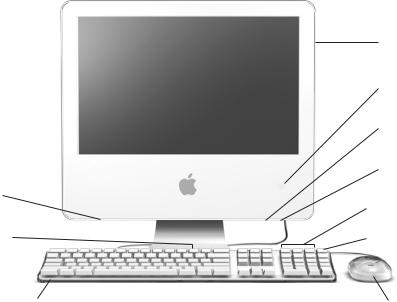
iMac G5 – Front View
Built-in speaker
 USB ports
USB ports
Apple Keyboard
12 |
Chapter 2 Getting to Know Your iMac G5 |
|
|
Slot-load optical disc drive
Power indicator light
Built-in microphone
Built-in speaker
 Volume controls
Volume controls
 Media Eject key
Media Eject key
Apple Mouse

Slot-load optical disc drive
Your computer has a slot-load DVD-ROM/CD-RW Combo drive or a SuperDrive. Both drives can read CD-ROM discs, photo CDs, standard audio discs, DVD discs, and DVD movies, and write music, documents, and other digital files to CD-R and CD-RW discs. If you have a SuperDrive, you can also burn your own iMovie creations on DVD using iDVD or write files and documents to blank DVD-R discs using the Finder.
Power indicator light
A white light indicates the computer is in sleep. When your iMac G5 is on, this light is off.
Built-in microphone
Record sounds directly on your iMac G5 or talk with friends live over the Internet using the included iChat AV application.
Built-in speakers
Listen to music, movies, games, and multimedia.
-Volume controls
Increase or decrease the volume of the sound coming from the built-in speakers and sound output port.
Media Eject key
Press and hold this key to eject a CD or DVD disc. You can also eject a disc by dragging its desktop icon to the Trash.
Apple Mouse
A precision optical mouse you can use on almost any surface, no mouse pad required.
Two USB (Universal Serial Bus) 1.1 ports on the Apple Keyboard
Connect low-power USB 1.1 devices to your iMac G5’s keyboard, such as mice, digital cameras, and joysticks. Connect your Apple Mouse to one of the keyboard USB ports. (There are also three highspeed USB 2.0 ports on the back of your computer.)
Chapter 2 Getting to Know Your iMac G5 |
13 |
|
|
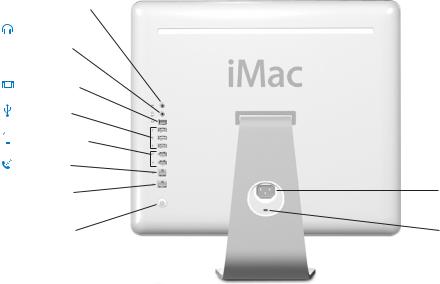
iMac G5 – Back View
 Audio line in port
Audio line in port
digital Headphone out/ optical audio
out port
Video out port
USB ports (3)
 FireWire ports (2)
FireWire ports (2)
Modem port
 Ethernet port (10/100Base-T)
Ethernet port (10/100Base-T)
® Power button
14 |
Chapter 2 Getting to Know Your iMac G5 |
|
|
Power port
Security slot

Audio line in port
Input audio into your iMac G5 from a line-level microphone or other audio equipment.
Headphone out/optical audio out port
digital
Connect headphones or other sound output devices. Or connect your iMac G5 to a receiver, home theater system, or other digital audio equipment using an optical audio cable with a mini-plug jack.
Video out port
Using the optional Apple VGA Display Adapter (available at www.apple.com/store), connect an external monitor or projection device that uses a VGA connector. Using the optional Apple Video Adapter (available at www.apple.com/store), connect a television, VCR, or other video device that uses an S-video or composite video connector.
Three USB (Universal Serial Bus) 2.0 ports
Connect printers, Zip and other disk drives, digital cameras, joysticks, and more. Connect both USB 1.1 and high-speed USB 2.0 devices.
Two FireWire 400 ports
Connect high-speed external devices, such as an iPod, digital video cameras, and external storage devices.
WModem port (on some models)
Connect a standard phone line directly to the internal 56K v.92 modem.
GEthernet port (10/100Base-T)
Connect to a high-speed 10/100Base-T Ethernet network, connect a DSL or cable modem, or connect to another computer and transfer files. The Ethernet port automatically detects other Ethernet devices. You don’t need an Ethernet crossover cable to connect to other Ethernet devices.
®
≤
Power button
Turn on your iMac G5 or put it to sleep. Press and hold to reset during troubleshooting.
Power port
Connect the computer’s power cord.
Security slot
Attach a lock and cable to prevent theft (available at www.apple.com/store).
Memory access (inside)
Your iMac G5 comes with at least 256 megabytes (MB) of 400 MHz, PC 3200 Double Data Rate Synchronous Dynamic Random Access Memory (DDR-SDRAM). You can add more memory to your iMac G5, up to a total of 2 GB. For more information and instructions on installing memory, see “Installing Additional Memory” on page 41.
AirPort Extreme Card slot (inside)
An AirPort Extreme Card in your computer allows you to connect to a wireless network. Your
iMac G5 may have come with an AirPort Extreme Card already installed. If not, you can purchase an AirPort Extreme Card and install it yourself. See “Installing an AirPort Extreme Card” on page 47.
Bluetooth® wireless technology (inside)
With the internal Bluetooth module (optional) you can connect wirelessly to devices, such as Bluetooth mobile phones, PDAs, printers, and the Apple Wireless Keyboard and Apple Wireless Mouse (you can purchase an Apple Wireless Keyboard and Mouse at www.apple.com/store).
Chapter 2 Getting to Know Your iMac G5 |
15 |
|
|
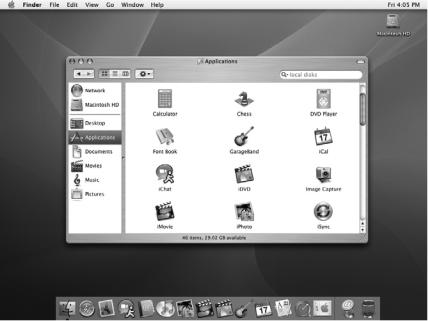
Learning About Mac OS X
Your computer comes with Mac OS X, which includes an elegant user interface, advanced graphics capabilities, and added system stability and performance.
When you’re ready to learn more about Mac OS X and the award-winning iLife applications that came with your computer, see the Welcome to Panther booklet that came with your iMac G5. Also open Mac OS Help and browse the information there. You’ll find plenty of information for new users, experienced users, and people switching to the Mac. If you experience any problems while using Mac OS X, see the troubleshooting tips in the back of this book or choose Help > Mac Help from the menu bar at the top of the screen.
For information about the compatibility of software applications with Mac OS X, or to read more about Mac OS X, check the Apple website: www.apple.com/macosx.
Note: If you want to use Mac OS 9 applications with your computer, you have to install Mac OS 9 (see “Installing Mac OS 9” on page 60). Mac OS 9 can’t be installed as the primary operating system on your iMac G5 and you can’t start up your computer in Mac OS 9.
16 |
Chapter 2 Getting to Know Your iMac G5 |
|
|
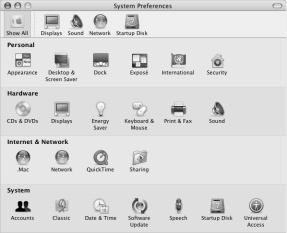
Customizing Your Desktop and Setting Your Preferences
You can quickly make your desktop look the way you want using System Preferences. Choose Apple (K) > System Preferences from the menu bar.
Feel free to make changes and experiment with the following:
•Desktop & Screen Saver: Select this preference pane to change the background color or pattern of your desktop, or change it to a photo or image you like. You can also choose an eye-catching screen effect that will appear on your screen when the computer is left idle.
•Dock: Select this preference pane to change the look, location, and behavior of your Dock.
•Appearance: Select this preference pane to change the colors of buttons, menus, windows, and highlight colors, among other options.
As you get to know your computer, explore the other System Preferences. It is your command center for most settings on your iMac G5. For more information, open Mac OS Help and search for “System Preferences” or for the specific preference you want to change.
Chapter 2 Getting to Know Your iMac G5 |
17 |
|
|
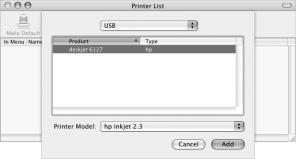
Connecting to a Printer
The drivers for most printers are built into Mac OS X. To use a printer with your iMac G5, follow the instructions that came with the printer to install any required software and connect the printer to your computer.
After connecting your printer, use the Print & Fax pane of System Preferences to select your printer for use.
Note: If you have an AirPort Extreme Card installed in your iMac G5 and you have an AirPort Extreme Base Station, you can connect a USB printer to the base station (instead of connecting it to your computer) and print wirelessly.
To set up a printer:
1 Open System Preferences and click the Print & Fax icon.
2 Click the Set Up Printers button.
3 Click the Add button.
4 Choose the type of connection for your printer (USB or Rendezvous in most cases).
To add a USB printer connected to an AirPort Extreme Base Station, choose Rendezvous from the pop-up menu.
5Select or enter your printer information and click Add.
Note: If you’re connecting to a printer via a network, you may need to know the network name or address of the printer to select it. Ask your network administrator.
18 |
Chapter 2 Getting to Know Your iMac G5 |
|
|

Monitoring Printing
Once you’ve sent a document to a printer, you can monitor, stop, or put printing temporarily on hold.
To monitor printing:
mClick the printer icon in the Dock to open the printer window.
You can now see the print jobs in the print queue and work with them. For more information, open Mac OS Help (see page 22) and search for “printing.”
Playing a CD and Connecting Headphones
If you’d like to listen to music while you work with your iMac G5, insert a music CD in your optical drive. iTunes, an easy-to-use music player, opens automatically. You can also connect headphones with a mini-jack to the headphone out/optical audio out
port ( ) of your iMac G5 to listen privately.
) of your iMac G5 to listen privately.
digital
To learn more about iTunes:
mOpen iTunes and choose Help > iTunes and Music Store Help.
To learn more about your optical drive, see “Using Your Optical Drive” on page 36.
Keeping Your Software Up to Date
You can connect to the Internet and automatically download and install the latest free software versions, drivers, and other enhancements from Apple.
When you are connected to the Internet, Software Update checks Apple’s servers to see if any updates are available for your computer. You can set your Mac to check the Apple server periodically and download and install updated software.
To check for updated software:
1Choose Apple (K) > Software Update. The Software Update window opens. If there are any updates available, they appear in a list.
2Click the checkbox to select the items you want to install, then click Install. Type an administrator name and password (the name and password you used when you first set up your computer).
When the updates complete, Software Update checks for updates again. It does this because some updates require that you have installed previous updates. For more information, search for “Software Update” in Mac OS Help (see page 22).
Chapter 2 Getting to Know Your iMac G5 |
19 |
|
|
Connecting a Camera or Other FireWire Device
If you have an iPod, iSight camera, FireWire digital video camera, or other device that has a FireWire connector, you can connect it to your iMac G5. Follow the installation instructions that came with your device. For more information about FireWire, see “FireWire” on page 26.
Connecting to a Network
If you want to connect your iMac G5 to an Ethernet network, cable or DSL modem, or a wireless network, see “Ethernet (10/100Base-T)” on page 31 and “AirPort Extreme Wireless Internet and Networking” on page 28 for more information about setting up an Ethernet or AirPort connection. Also open Mac OS Help (see page 22) and search for “Ethernet” or “AirPort” for further help.
Using the Internet
When you first set up your iMac G5, you were instructed on how to connect to the Internet. If you need to change to a different type of connection, such as a DSL or cable modem, Ethernet local area network (LAN), or AirPort Extreme network, you can find more information in Appendix C,“Connecting to the Internet,” on page 69.
Transferring Files to Another Computer
You have several ways to transfer files or documents to or from your iMac G5.
•You can easily transfer files using the Setup Assistant. For more information, see “Transferring Information to Your iMac G5” on page 8.
•You can transfer files via the Internet using .Mac or another Internet account. Go to www.mac.com for more information.
•If your computer is connected to an Ethernet network, you can transfer files to another computer on the network. To access another server or computer, open a Finder window and click Network. Or if you know the name or network address of the computer, choose Go > Connect to Server from the Finder menu bar.
•You can create a small Ethernet network by connecting an Ethernet cable from your iMac G5 to another computer’s Ethernet port. For more information, open Mac OS Help and search for “Connecting two computers.”
•You can also connect to another Mac using a FireWire cable. Your iMac G5 appears as a disk drive on the other computer and you can transfer files. For information about using FireWire to transfer files, see “FireWire Target Disk Mode” on page 27.
•If your computer has an AirPort Extreme Card, you can connect to an AirPort wireless network to transfer files. For more information, see “AirPort Extreme Wireless Internet and Networking” on page 28.
20 |
Chapter 2 Getting to Know Your iMac G5 |
|
|

For more information about transferring files and documents, open Mac OS Help (see page 22) and search for “transferring files.”
When an Application Freezes
On rare occasions, an application may freeze on the screen. Mac OS X provides a way to quit a frozen application without restarting your computer. Quitting a frozen application may allow you to save your work in other open applications.
To force an application to quit:
1Press Command (x)-Option-Esc.
The Force Quit Applications dialog appears with the application selected.
2Click Force Quit.
The application quits, leaving all other applications open.
If needed, you can force the Classic environment to quit, which closes all Classic applications. You can also restart the Finder from this dialog.
If you’re experiencing other problems, see Chapter 5,“Troubleshooting,” on page 57.
Chapter 2 Getting to Know Your iMac G5 |
21 |
|
|
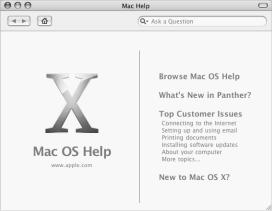
Getting Answers to Your Questions Using Mac OS Help
You can find answers to most of your questions about using your computer and
Mac OS X in Mac OS Help.
To use Mac OS Help:
1 Click the Finder icon in the Dock.
2 Choose Help > Mac Help (click the Help menu and choose Mac Help).
3 Type a question and press the Return key on your keyboard.
4 Double-click an item in the list of Help topics.
Using Applications
Your iMac G5 comes with software applications, including the iLife Suite of applications, for doing things like sending email, surfing the Internet, chatting online, organizing music and digital photos, making movies, and much more. For more information on these applications, see the Welcome to Panther booklet that came with your computer.
22 |
Chapter 2 Getting to Know Your iMac G5 |
|
|

3 |
Using Your Computer |
3 |
|
||
|
|
|
Your iMac G5 has many built-in features and expansion capabilities you can use to customize your computer to fit your needs.
Here are some of your computer’s features and capabilities:
•High-speed Universal Serial Bus (USB) 2.0 ports for connecting additional equipment, such as printers, scanners, joysticks, keyboards, digital cameras, and floppy disk drives.
•FireWire 400 ports for connecting high-speed equipment, such as an iPod, iSight camera, digital video cameras, and external hard disk drives.
•Optional Bluetooth module for connecting wirelessly to digital devices.
•The latest in communications technologies, such as a 56K v.92 modem (on some models), 10/100Base-T Ethernet, and optional AirPort Extreme wireless networking.
•Combination headphone out/optical audio out port to connect headphones or digital audio equipment.
•VGA output with the Apple VGA Display Adapter (available at www.apple.com/store) lets you use your iMac G5 with an external monitor or video projector.
Use your iMac G5’s video out port and the Apple Video Adapter (available at www.apple.com/store) to present what’s on your computer’s screen on any television that supports composite or S-video.
To learn about what you can do with your iMac G5, start with the information in this chapter. Additional information can be found in Mac OS Help (see page 22) and on the Apple website.
23
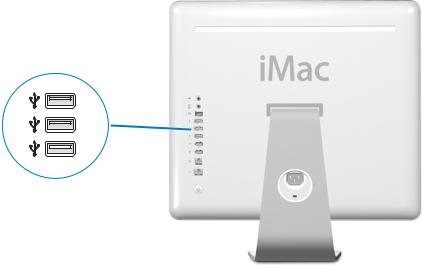
Universal Serial Bus (USB)
Your iMac G5 comes with five USB ports ( ) (three high-speed USB 2.0 ports on the back of the computer and two USB 1.1 ports on the keyboard), which you can use to connect many types of external devices, including printers, scanners, digital cameras, game pads, joysticks, keyboards, and floppy disk drives. USB makes it easy to connect peripherals. In most cases you can connect and disconnect a USB device while the computer is running. Once you connect the device, it is ready to use.
) (three high-speed USB 2.0 ports on the back of the computer and two USB 1.1 ports on the keyboard), which you can use to connect many types of external devices, including printers, scanners, digital cameras, game pads, joysticks, keyboards, and floppy disk drives. USB makes it easy to connect peripherals. In most cases you can connect and disconnect a USB device while the computer is running. Once you connect the device, it is ready to use.
USB ports
Using USB Devices
To use a USB device with your computer, simply connect the device to the computer. Your computer automatically accesses the necessary software whenever you connect a new device.
You can connect USB 1.1 devices and high-speed USB 2.0 devices to the USB 2.0 ports on the back of your computer. USB 1.1 devices won’t take advantage of the USB 2.0 higher transfer rate.
Likewise, you can connect USB 2.0 devices to the USB 1.1 ports on your keyboard, but they may operate at slower speeds.
Note: Apple has already included software to work with many USB devices. When you connect a USB device, if your iMac G5 cannot find the correct software, you can install the software that came with the device or check the device manufacturer’s website for the latest software.
24 |
Chapter 3 Using Your Computer |
|
|
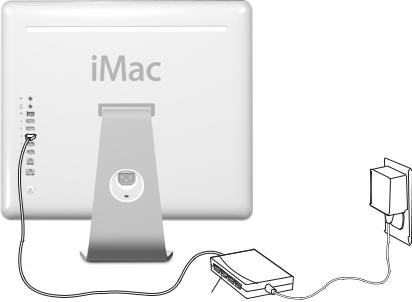
Using Multiple USB Devices at the Same Time
If all of your USB ports are being used and you want to connect more USB devices, you can purchase a USB hub. The USB hub connects to an open USB port on your computer and provides additional USB ports (usually four or seven). Most USB hubs also have a power adapter and should be plugged into an outlet.
USB hub
For More Information on USB
Additional information on USB is available in Mac OS Help (see page 22). Choose Help > Mac Help and search for “USB.”You can also find information on the Apple USB website at www.apple.com/usb.
For information on USB devices available for your computer, check the Macintosh Products Guide at www.apple.com/guide.
Chapter 3 Using Your Computer |
25 |
|
|
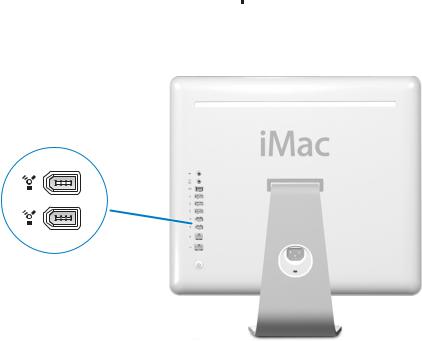
FireWire
Your computer has two FireWire 400 ports (
 ). FireWire lets you easily connect and disconnect external high-speed devices—such as an iPod, an iSight camera, digital video cameras, printers, scanners, and hard disks. You can connect and disconnect FireWire devices without restarting your computer.
). FireWire lets you easily connect and disconnect external high-speed devices—such as an iPod, an iSight camera, digital video cameras, printers, scanners, and hard disks. You can connect and disconnect FireWire devices without restarting your computer.
FireWire ports
These are some of the things you can do with FireWire:
•Connect an iPod and transfer thousands of songs from iTunes or synchronize contact and calendar information using iSync.
•Connect an Apple iSight camera and use the included iChat AV application to videoconference with friends and family over a high-speed Internet connection.
•Connect a digital video camera and capture, transfer, and edit high-quality video directly on your computer using video-editing software such as iMovie (included with your computer), Final Cut Express, or Final Cut Pro.
•Connect an external FireWire hard disk drive and use it to back up data or transfer files. A FireWire hard disk icon appears on your desktop after you connect the drive to your iMac G5.
•Start up from an external FireWire hard disk. Connect an external FireWire disk (with a valid operating system installed on it), open the Startup Disk pane of System Preferences, and click the FireWire disk. Restart your computer.
26 |
Chapter 3 Using Your Computer |
|
|
Using FireWire Devices
To use a FireWire device with your computer, simply connect the device to the computer. Apple has already included software to work with many FireWire devices. When you connect a FireWire device, if your iMac G5 cannot find the correct software, you can install the software that came with the device or check the device manufacturer’s website for the latest software.
Note: The FireWire port is designed to provide power for FireWire devices (up to a total of 8 watts). You can connect multiple devices to each other and connect the “daisy-chain” of devices to the FireWire port on your computer. In most cases, at most two devices should get power from the computer. If you connect more than two devices, the rest of the devices in the daisy-chain should be powered by separate power adapters. Connecting more than two FireWire devices that get power from the computer may cause problems. If a problem occurs, shut down the computer, disconnect the FireWire devices, and restart your computer.
FireWire Target Disk Mode
If you want to transfer files between your iMac G5 and another FireWire-equipped computer, or you have a problem that prevents your computer from starting up, you can use FireWire Target Disk Mode to connect to another computer.
To connect your iMac G5 in FireWire Target Disk Mode, follow these steps: 1 Make sure that your iMac G5 is shut down.
2Use a FireWire cable with a standard 6-pin connector on each end to connect your iMac G5 to another FireWire-equipped computer.
3Start up your iMac G5 and immediately hold down the T key. Your iMac G5 display shows the FireWire logo. The other computer’s display shows the iMac G5 internal hard disk icon and the icon of a CD or DVD disc in the iMac G5’s optical drive.
4When you are finished transferring files, drag the iMac G5 hard disk icon and the CD or DVD disc icon to the Trash.
5Press the power button on the iMac G5 to shut it down, and then disconnect the FireWire cable.
For More Information on FireWire
Additional information on FireWire is available in Mac OS Help (see page 22). Choose Help > Mac Help and search for “FireWire.”You can also find information on the Apple FireWire website at www.apple.com/firewire.
Chapter 3 Using Your Computer |
27 |
|
|

AirPort Extreme Wireless Internet and Networking
Your iMac G5 is AirPort Extreme-ready. If you ordered an AirPort Extreme Card when you purchased your iMac G5, the card is already installed. If you do not have an AirPort Extreme Card installed and would like to install one, see page 47 for more information.
AirPort offers an easy and affordable way to provide wireless Internet access anywhere in the home, at work, or in the classroom. Instead of using traditional cables, AirPort uses wireless local area network (LAN) technology to provide wireless communication between multiple computers. Through a wireless network, you can set up access to the Internet, transfer files, play multiplayer games, and more.
Note: Wireless Internet access requires an AirPort Extreme Card. Previous models of AirPort Card are not compatible with your computer. You also need an AirPort Base Station and Internet access (fees may apply). Some Internet service providers are not currently compatible with AirPort. Range may vary with site conditions.
How AirPort Provides Wireless Internet Access
With AirPort, you set up a wireless connection to a device known as a base station, which has a physical connection to the Internet. AirPort technology works like a cordless telephone. The AirPort Extreme Card in the computer makes a wireless connection to the base station, which is connected to the Internet via a telephone line or a DSL or cable modem.
Connection to the Internet
AC outlet
AirPort Extreme
Base Station
|
|
|
|
|
|
|
|
|
|
|
|
|
|
|
|
|
|
|
|
|
|
|
|
|
|
|
|
|
|
28 |
|
Chapter 3 Using Your Computer |
|
|
|||||
|
|
|
|||||||
|
|
|
|
|
|
|
|
|
|
For More Information on AirPort
To purchase an AirPort Base Station, contact your Apple-authorized dealer or go to the Apple Store at www.apple.com/store.
Additional information on AirPort is available in AirPort Help. Choose Help > Mac Help, then choose Library > AirPort Help. You can also find information on the Apple AirPort website at www.apple.com/airport and in the Apple Knowledge Base at kbase.info.apple.com.
Bluetooth Wireless Technology
If your iMac G5 has the optional Bluetooth module, you can connect to devices that use Bluetooth wireless technology, such as mobile phones, PDAs, printers, and the Apple Wireless Keyboard and Apple Wireless Mouse (available for purchase at www.apple.com/store).
With Bluetooth wireless technology, you can do the following:
•Use your iMac G5 to communicate with a mobile phone equipped with Bluetooth wireless technology. Your phone can act as a modem to connect you to a wireless service provider, at speeds of up to 56 kilobits per second (kbit/s), so you can use your mobile phone to access the Internet.
•Communicate with your handheld PDA. Using iSync, you can perform a hot sync operation without cables or send your business card or calendar events directly to a colleague’s PDA.
•Transfer files between computers, even Mac to PC, using the transfer utility. Apple still recommends the use of AirPort Extreme wireless networking, however, for anything but the smallest files.
•Use a Bluetooth wireless keyboard or mouse.
To set up a Bluetooth device:
mUse the Bluetooth Setup Assistant, located in the Applications/Utilities folder on your hard disk.
You can also choose “Set up Bluetooth Device” from the Bluetooth status menu in the menu bar.
Setting Up Bluetooth File Exchange
You can control how your computer handles files that are exchanged between it and other Bluetooth devices. You can choose a folder for the files you accept from other devices, a folder for other devices to browse, and which applications to use to open the files you accept.
To set up a Bluetooth file exchange:
m Open System Preferences and click Bluetooth, then click File Exchange.
Chapter 3 Using Your Computer |
29 |
|
|
